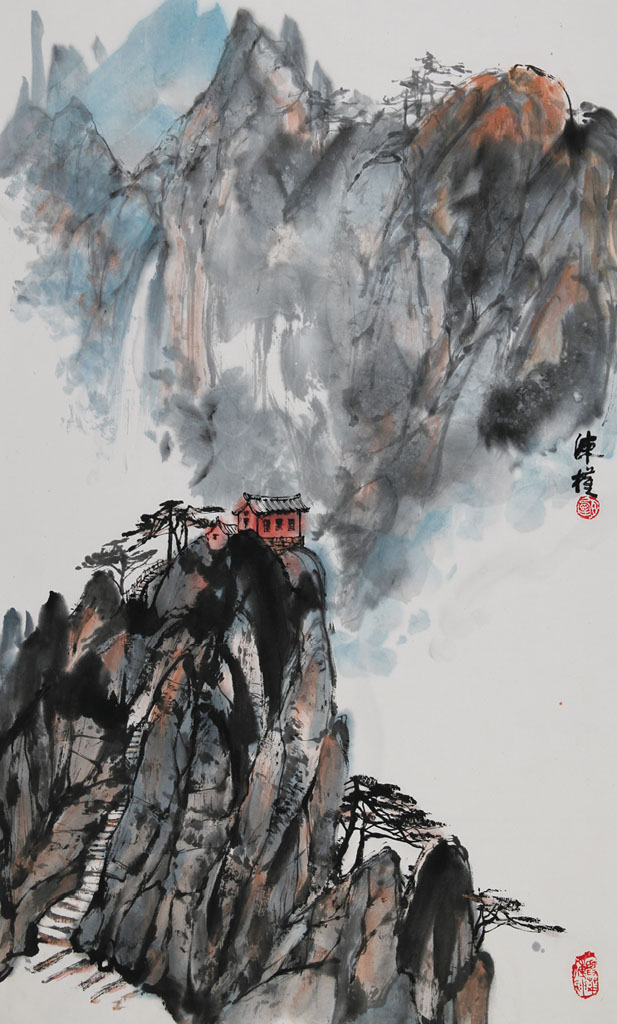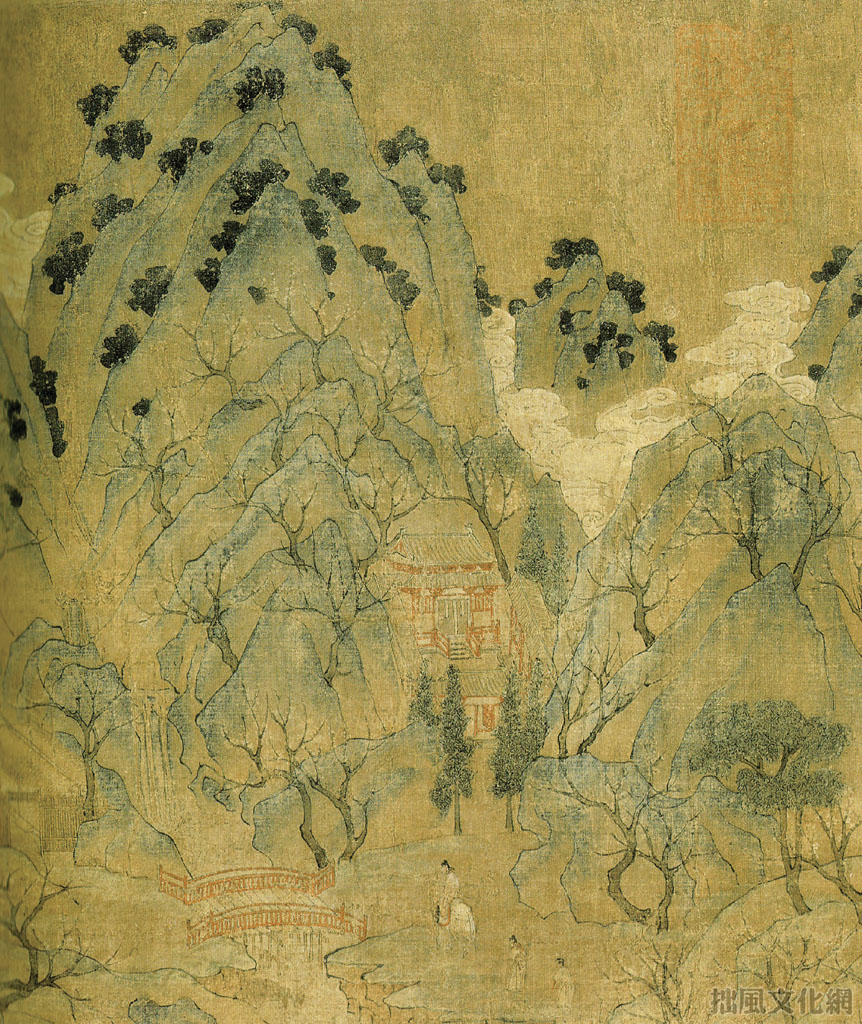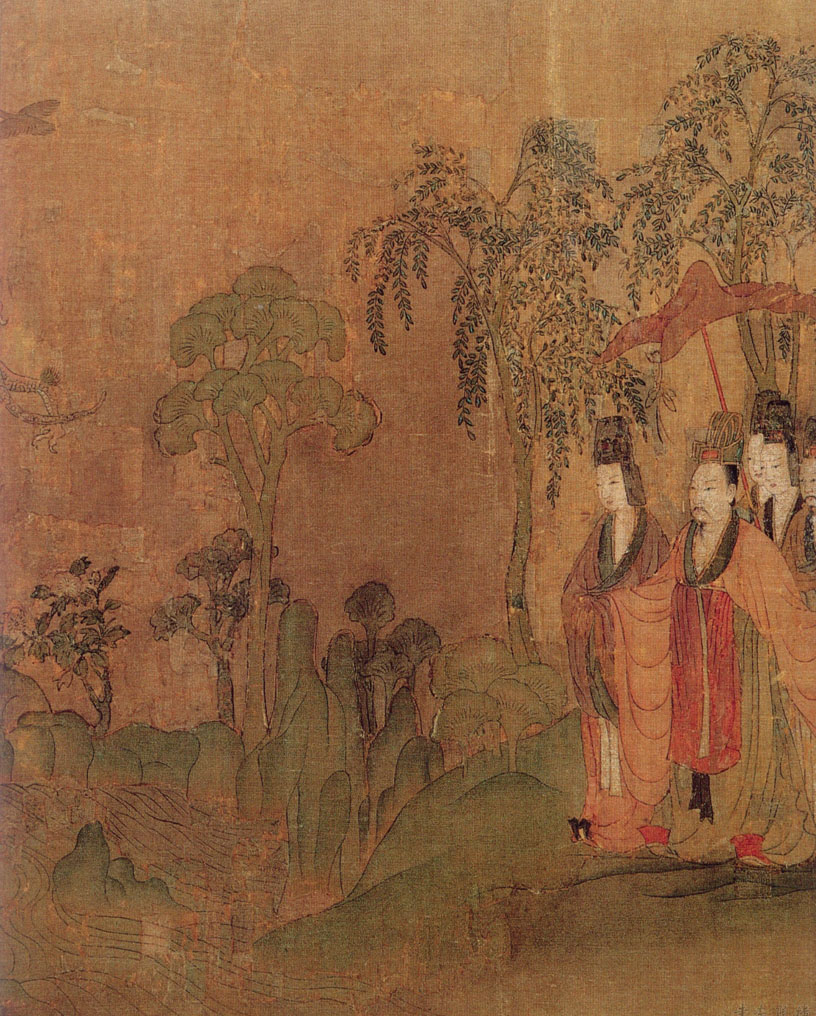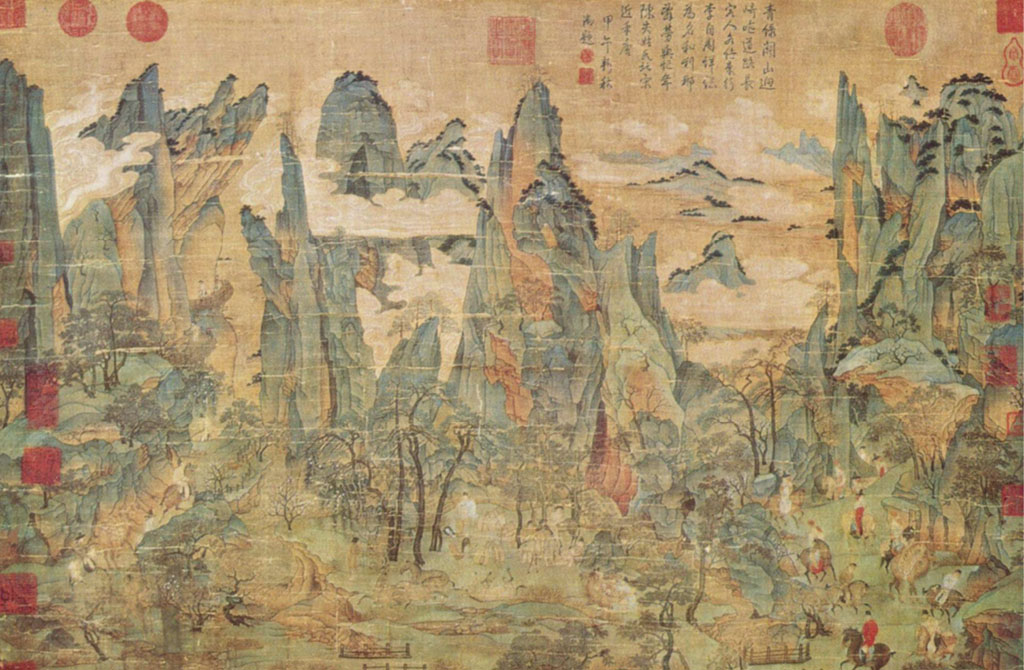
YELLOW MOUNTAIN
The three traditional categories of Chinese painting are figure paintings, landscapes and flower-bird paintings. Leading up to the fifth century, Chinese artists painted landscapes mainly as backdrops for their figure paintings. Landscape elements such as mountains, rocks, trees and lakes were underdeveloped, out of proportion and lacking delineated techniques.
Toward the early part of the Sui Dynasty through the Tang Dynasty (approximately a.d. 589–906), Chinese artists started painting landscapes independently from figures. Their techniques were simple. Dominant landscape elements such as mountains, rocks, clouds, rivers and boats were outlined with thin and uniform ink strokes and filled in with vivid colors such as greens, blues and sienna. A variety of strokes were used to suggest texture, and over time proportions were rendered more accurately and objects were overlapped in a contrasting fashion. This era represented the emergence of the blue-green landscape.
Landscapes continued to evolve dramatically between the Five Dynasties Period and the Sung Dynasty (a.d. 907–1279) into two main styles: blue-green landscapes and water-ink landscapes. Early blue-green landscapes were embellished with gold outlines, and over time developed into a loose style of painting that emphasized ink embellishments and renderings. Today this spontaneous style of painting, sometimes referred to as scholar style, continues to dominate Chinese landscape painting. Water-ink landscapes also became important aspects of Chinese landscapes. These simple, spontaneous-style paintings relied heavily on inks and vivid brushwork. They are called shui-mo hua in China and sumi-e in Japan.

YELLOW MOUNTAIN
Ink and color on raw Shuan paper
22” × 16” (56cm × 41cm)
Also known as scholar style, this form of Chinese painting developed during the Sung Dynasty and continues to dominate today. It is characterized by the subtle use of ink as well as expressive brushwork to indicate the textures of mountains, rocks, water, clouds and other natural elements. In spontaneous-style paintings, color is secondary to the ink renderings.

An early example of a blue-green style Chinese landscape painted by Zhan Ziqian featuring mountains and trees thinly outlined with ink and filled in with vivid greens, blues and browns.

This sample of a long scroll painted by Gui Kaizhi circa a.d. 380 is an example of an early Chinese painting of beautifully rendered figures and small, unstylized trees and hills.
Throughout feudal China, the goal of the scholarly painter remained with capturing the spirit and truth of nature. Art from the Yuan Dynasty (a.d. 1279 –1368) into the early Ming Dynasty (a.d. 1368–1644) was known as literati painting. Inks and elaborate brushwork were used to embellish subjects with the goal of capturing the spirit and beauty of nature. Skilled landscapes were not merely impressions of nature, but revealed a harmony between humans and nature: art as poetry. Chinese landscapes continued to progress in this way with the goal of mastering the spiritual and personal side of art rather than literal interpretation and formal technique. During the Ming Dynasty, artists began inscribing poems into their landscapes to express personal feelings and philosophies.
During the Ch’ing Dynasty (a.d. 1644–1912), landscape painting trended to the copying of ancient masters. Critiques of painting shifted away from nature and personal spiritual attainment to technique. Toward the turn of the twentieth century, however, Western art styles began to influence Chinese artists, and new blended styles began to emerge. Zhang Daqian is a well-known Chinese artist noted for his splashed-ink pouring technique, thought to be derived from the abstract expressionist movement popular in the United States.
From the early 1900s through the 1950s, a group of Cantonese painters from the Guangdong Province next to Hong Kong developed a new movement combining traditional Chinese painting with Japanese and Western painting styles. Their goal was to shift Chinese painting history into the modern age, away from feudal China and into modern society. Not only did they master traditional theories and techniques, they also sketched outdoors to observe their landscapes firsthand, thus developing more natural colors and accurate proportions and perspectives. They also used nontraditional Shuan paper to suit their particular painting methods. This new Chinese painting school is known as the Lingnan School of Painting and today is popular in southern China, Hong Kong, Taiwan and abroad.
Ling Nan literally translates to southern side of the mountains in reference to Guangdong Province. I was born and raised there before I moved to the U.S. I enjoy Lingnan School paintings in general because they have beautiful colors with traditional Chinese painting techniques. Most importantly, I admire the courage of the style’s creators to break free from the Chinese painting styles of history.

As the blue-green style of painting evolved into maturity, the style was characterized by nature elements depicted in greens, blues, reds and sometimes outlined thinly in gold.

SERENITY
Joan Chan Lok Chinese ink and color on Japanese cotton paper 16” × 25” (41cm × 64cm)
This painting was completed in the Lingnan School style by Joan Chan Lok, president of the National Sumi-e Society of America.